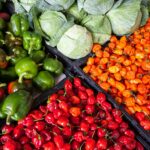Rise of Food Delivery Apps
In today’s fast-paced world, the convenience provided by food delivery apps has revolutionized the way we dine. With just a few taps on a smartphone, individuals can have their favorite meals delivered right to their doorstep, saving precious time and effort. This shift in consumer behavior has significantly altered traditional eating habits, making it easier for people to access a wide range of culinary options without having to leave the comfort of their homes.
The widespread adoption of food delivery apps has not only streamlined the ordering process but has also opened up new opportunities for restaurants and food establishments to reach a larger customer base. By partnering with these platforms, eateries can expand their reach beyond their physical locations, attracting a diverse clientele that may not have otherwise discovered their offerings. This symbiotic relationship between food delivery apps and restaurants has reshaped the dining landscape, catering to the evolving preferences and lifestyles of modern consumers.
Changing Eating Patterns
The proliferation of food delivery apps has been a key driver in the evolution of modern eating habits. With the convenience and efficiency they offer, consumers are increasingly turning to these platforms to satisfy their culinary cravings. The benefits of food delivery, such as time savings and a diverse range of options, have influenced the way people approach meal planning and consumption.
Moreover, the trends observed in delivery apps reflect a shift towards a more tech-savvy and on-the-go lifestyle. This has not only impacted the way meals are ordered and consumed but also the type of food that is in demand. As consumers continue to embrace the ease and accessibility of food delivery services, it is evident that these changing eating patterns are here to stay, shaping the way we experience and interact with food on a daily basis.
Benefits of Food Delivery
In today’s fast-paced world, the convenience of food delivery apps has become a saving grace for many individuals with busy schedules. Popular apps like Uber Eats and DoorDash offer a wide range of cuisines from various restaurants, providing customers with the flexibility to enjoy their favorite meals without leaving their home or office. Additionally, these apps often feature special promotions and discounts, making dining out more affordable and accessible.
Moreover, the emergence of healthy delivery options on these platforms has revolutionized the way people approach their dietary habits. Customers can now choose from a plethora of nutritious meals that cater to their specific dietary needs and preferences, promoting a balanced and wholesome eating lifestyle. With just a few taps on their smartphones, individuals can enjoy fresh and healthy meals without compromising on taste or quality, enhancing their overall well-being.
Potential Downsides
While food delivery apps have revolutionized the way we dine by providing easy access to a wide range of cuisines, there are potential downsides to this convenience. One significant issue is the impact of food delivery on traditional dining establishments. Many small restaurants struggle to compete with the digital giants dominating the market, leading to a decline in their revenue and customer base. The increasing reliance on app-based food delivery services also raises concerns about the sustainability of local eateries in the long run.
Moreover, the integration of technology in food delivery has raised questions regarding data privacy and security. As consumers place orders online and share personal information such as addresses and payment details, there is a risk of this data being misused or compromised. Additionally, the dependence on technology for meal delivery may limit the human interaction that is often cherished in the dining experience, potentially affecting customer satisfaction and loyalty in the ever-evolving landscape of the food industry.
Popular Food Delivery Apps
In today’s digital age, consumer behavior has significantly shifted towards convenience and efficiency, leading to the exponential growth of food delivery apps. These platforms have revolutionized the way people dine, offering a plethora of restaurant options at the touch of a button. As the future of food apps continues to evolve, we can anticipate even more advanced features and personalized services to cater to the diverse needs of users.
With a wide array of popular food delivery apps available in the market, consumers are spoilt for choice when it comes to satisfying their cravings. From industry giants like UberEats and DoorDash to niche platforms specializing in specific cuisines, there is a delivery app for every palate and preference. The competitive landscape of food delivery services not only benefits consumers through increased options and convenience but also drives innovation and improvement in the overall user experience.
• UberEats: Known for its wide range of restaurant options and efficient delivery service
• DoorDash: Offers quick delivery times and user-friendly interface for ordering
• Grubhub: Specializes in connecting users with local restaurants for a personalized dining experience
• Postmates: Stands out for its unique feature of delivering not only food but also groceries, alcohol, and more
• Seamless: Focuses on seamless ordering process and reliable delivery services
As these popular food delivery apps continue to dominate the market, they are constantly innovating to stay ahead of the competition. Features such as real-time tracking, customized recommendations based on past orders, and loyalty programs are just some of the ways these platforms enhance user satisfaction. Moreover, partnerships with restaurants and exclusive deals further entice consumers to choose these apps over traditional dining options.
In addition to convenience and variety, food delivery apps have also played a crucial role in supporting local businesses during challenging times such as the COVID-19 pandemic. By providing a platform for smaller eateries to reach a wider audience, these apps have helped many establishments stay afloat amidst lockdowns and restrictions. The symbiotic relationship between food delivery apps and restaurants is essential in fostering growth within the culinary industry.
Looking ahead, we can expect continuous advancements in technology that will further streamline the food delivery process. From drone deliveries to AI-powered recommendations, the future of food apps holds endless possibilities for enhancing user experience. As consumer demands evolve, so too will these platforms adapt to meet their needs effectively while maintaining high standards of quality service.
Healthy Options on Delivery Apps
Consumers are increasingly turning to food delivery apps in their quest for convenient and healthy meal options. With the rise of health-conscious individuals, the demand for nutritious choices on these platforms has surged. Many top food delivery apps now offer a variety of healthy dishes to cater to this growing segment of the market.
From fresh salads and lean protein bowls to plant-based entrees and gluten-free options, users can now access a diverse range of nutritious meals at the touch of a button. These menus not only cater to health-conscious consumers but also appeal to those with specific dietary restrictions or preferences. By incorporating these healthy choices, food delivery apps have been able to position themselves as advocates of overall well-being and provide a more holistic dining experience for their users.
Future of Food Delivery
As technology continues to advance rapidly, the future of food delivery appears promising and innovative. With the integration of artificial intelligence and machine learning algorithms, food delivery apps will offer more personalized recommendations, making the ordering process even more convenient for users. Moreover, the use of drones and autonomous vehicles for delivering food is on the horizon, promising quicker and more efficient delivery services.
Furthermore, sustainability and environmentally friendly practices are becoming increasingly important in the food industry. In the future, we can expect food delivery apps to prioritize eco-friendly packaging options and partner with sustainable restaurants to reduce their carbon footprint. Additionally, there is a growing focus on healthy eating, and food delivery apps are likely to expand their offerings of nutritious and wholesome meals to cater to health-conscious consumers.




